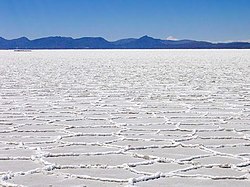Salar de Uyuni | |
|---|---|
 Hexagonal formations on the surface of the Salar de Uyuni as a result of salt crystallization from evaporating water | |
| Coordinates: 20°08′01.59″S 67°29′20.88″W / 20.1337750°S 67.4891333°W | |
| Location | Daniel Campos Province, Potosí Department |
| Formed by | Evaporation |
| Area | |
| • Total | 10,582 square kilometres (1,058,200 ha) |
| Dimensions | |
| • Depth | 130 metres (430 ft) |
| Elevation | 3,663 m (12,018 ft) |
Salar de Uyuni (or "Salar de Tunupa")[1] is the world's largest salt flat, or playa, at 10,582 square kilometres (4,086 sq mi) in area.[2][3] It is in the Daniel Campos Province in Potosí in southwest Bolivia, near the crest of the Andes at an elevation of 3,656 m (11,995 ft) above sea level.[4]
The Salar was formed as a result of transformations between several prehistoric lakes that existed around forty thousand years ago but had all evaporated over time.[2] It is now covered by a few meters of salt crust, which has an extraordinary flatness with the average elevation variations within one meter over the entire area of the Salar. The crust serves as a source of salt and covers a pool of brine, which is exceptionally rich in lithium. The large area, clear skies, and exceptional flatness of the surface make the Salar ideal for calibrating the altimeters of Earth observation satellites.[5][6][7][8][9] Following rain, a thin layer of dead calm water transforms the flat into the world's largest mirror, 129 km (80 miles) across.[10]
The Salar serves as the major transport route across the Bolivian Altiplano and is a prime breeding ground for several species of flamingos. Salar de Uyuni is also a climatological transitional zone since the towering tropical cumulus congestus and cumulonimbus incus clouds that form in the eastern part of the salt flat during the summer cannot permeate beyond its drier western edges, near the Chilean border and the Atacama Desert.[citation needed]
The Salar has been used as a filming location for movies such as Star Wars: The Last Jedi (2017; as planet Crait),[11][12] The Fall (2006), Salt and Fire (2016), The Unseen (2017), and several others.
- ^ "Salar de Tunupa". Iris en Tore op reis. 29 July 2011. Archived from the original on 19 January 2016. Retrieved 26 February 2016.
- ^ a b "Lithium Harvesting at Salar de Uyuni". Earth Observatory. NASA. 12 April 2013.
- ^ Mills, Andrea (2015). Strange but True (1st ed.). London: Penguin Random House. pp. 8–9. ISBN 978-3-8310-3074-3.
- ^ "Uyuni Salt Flat". Encyclopædia Britannica. Retrieved 1 December 2007.[permanent dead link]
- ^ Cite error: The named reference
nature2was invoked but never defined (see the help page). - ^ Cite error: The named reference
geowas invoked but never defined (see the help page). - ^ Cite error: The named reference
reflwas invoked but never defined (see the help page). - ^ Borsa, A. A; et al. (2002). "GPS Survey of the salar de Uyuni, Bolivia, for Satellite Altimeter Calibration". American Geophysical Union, Fall Meeting. Bibcode:2002AGUFMOS52A0193B.
- ^ Lamparelli, R. A. C.; et al. (2003). "Characterization of the Salar de Uyuni for in-orbit satellite calibration". IEEE Trans. Geosci. Remote Sens. 41 (6): 1461–1468. Bibcode:2003ITGRS..41.1461C. doi:10.1109/TGRS.2003.810713. S2CID 18716304.
- ^ "Kingdoms of the Sky: Salt Flat Landscape Creates the World's Largest Mirror". PBS. 25 July 2018.
Sudden rains leave a layer of dead calm water just an inch deep, turning the salt flat into a natural wonder: the world's largest mirror, eighty miles across. At night, the landscape is transformed again into a 360-degree starscape. This dazzling show is only possible because the Salar de Uyuni is perfectly flat.
- ^ "Crait: The Salar de Uyuni Star Wars Planet". salardeuyuni. salardeuyuni.com. 24 August 2018. Retrieved 11 April 2020.
- ^ Butler, Alex. "Star Wars: The Last Jedi filming locations around the world". Lonely Planet. Retrieved 11 April 2020.
